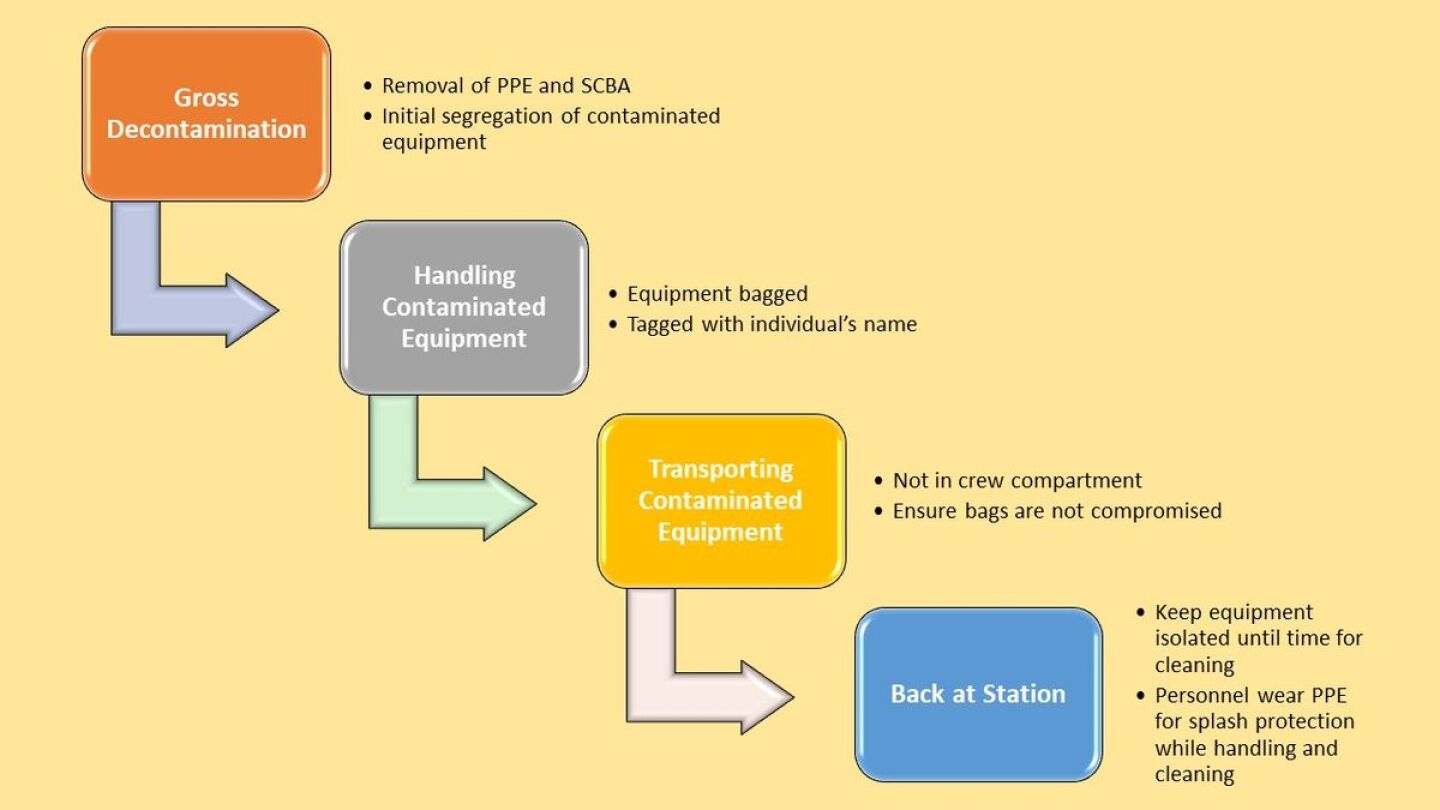Studies have shown that firefighter turnout gear and PPE that gets coated with toxic agents from the fireground can continue to transfer and off-gas contaminants long after the incident has ended. This article follows firefighter gear from contamination, through doffing, transport and cleaning to identify potential areas for exposure in the gear contamination cycle.
The fire contamination hazard area
Today’s typical structure fire involves the high temperature destruction of many types of plastics, foams, various species of wood, fabrics and other materials. Gases and particulates liberated from these burning materials often contain toxic, reactive and otherwise unhealthy chemicals that are both inhalation hazards and skin absorption hazards.
Several studies have shown that during interior firefighting operations there are many toxic substances and compounds present, particularly during the overhaul phase of those operations, that exceed ceiling values promulgated at the time by the American Conference of Governmental Industrial Hygienists or the National Institute for Occupational Safety and Health.
Among those substances and compounds that were most frequently present were:
- Acrolein.
- Carbon monoxide (CO).
- Formaldehyde.
- Glutaraldehyde.
- Benzene.
- Nitrogen dioxide (NO2).
- Sulfur dioxide (SO2).
Gross decontamination
Once a firefighter leaves the hazard area, the potential for secondary contamination begins. The first action to prevent that secondary contamination is for the firefighter to undergo a gross decontamination to remove as much of the external contaminants as possible from the outer surface is of their PPE.
Handling contaminated firefighter PPE
The second action that must occur is properly managing the PPE and SCBA that have been through the gross decon process. Such gear and protective clothing should be treated as hazardous until it’s been cleaned and dried back at the station.
Let’s be clear: The key word in gross decontamination is “gross.” PPE and SCBA that have been through gross decon will still maintain surface contaminants, and impregnated substances and compounds that can only be removed during advanced cleaning back at the fire station.
The hazard in this case is the potentially contaminated water still contained in the PPE as well as any absorbed substances or compounds that can off gas. All PPE and SCBA should be bagged in heavy duty plastic bags for transport back to quarters.
Transporting contaminated PPE
The transportation of contaminated equipment back to the station presents another secondary contamination challenge that must be resolved. The compartment space on most fire apparatus is already “spoken for” with other stored equipment and appliances; firefighters and officers must reevaluate how the available storage space is allocated and make the necessary adjustments to accommodate transporting contaminated gear.
The one absolute is that the bagged contaminated gear, including SCBA, cannot be transported in the crew cab. Doing so could expose personnel to secondary contamination should there be leakage from a bag. It would also create another space – the crew cab – that needs to be decontaminated back at the fire station.
Most existing fire apparatus are not likely to have been designed for the transportation of contaminated equipment. Proper bagging of that gear, with great care to prevent rips, tears or punctures, is necessary to prevent the release of contaminated water into an apparatus compartment. Failure to do so will result in additional actions to decontaminate such a compartment upon return to the quarters.
Off-loading PPE and staging for washing
All contaminated gear should remain bagged and isolated within the fire station until it’s time for advance cleaning. Equipment should move directly from its stored location to the cleaning process before being removed from bags.
All personnel handling bagged equipment back at the station should wear equipment to protect them from liquid splashes (e.g., eye protection, gloves, and a rubber apron or Tyvek coveralls.)
Does any of this sound familiar?
If much of this sounds familiar, it’s likely because you and your fire department provide EMS to your community. As such, you’ve had to learn how to take proper care with hazardous waste and contaminated equipment as you cleaned up an emergency scene before returning to service. That’s why I stated earlier in this article that you need to treat your contaminated PPE and SCBA just like you’ve always treated EMS waste and contaminated patient care equipment.
Why reinvent the wheel?
--
The views of the author contained in this article do not necessarily reflect those of the sponsor.





